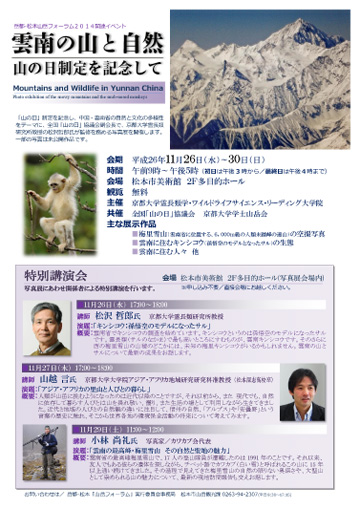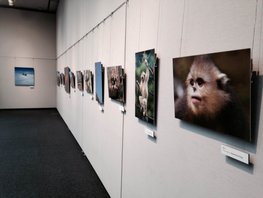

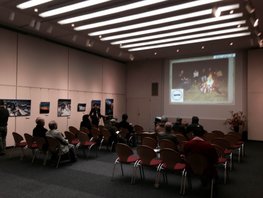

This photo exhibition about "Snowy Mountains and the Snub-nosed Monkeys" is opened in Matsumoto City Museum of Art. Excellent animal photography requires experience, knowledge and patience. Snow mountain photography is always more than meet the eye. Aerial photography is one of the most intense and most extreme moments which require great skill to create and awesome effect and a good picture. All the exhibits took the fancy of the visitors very much. To conclude, this photo exhibition is informative and fantastic, it will become a bridge, literally and figuratively, between China and Japan. I wish not only a prosperous friendship between the peoples of China and Japan but also a sister-city relationship with Lijiang and Matsumoto.
Cette exposition de photos sur les ‘Montagnes neigeuses et Singes au nez-retroussé’ est présentée au Musée d’Art de la ville de Matsumoto. Une excellente photographie animalière nécessite de l’expérience, de la connaissance et de la patience. La photographie de montagne en neige est bien plus complexe qu’il n’y parait. La photographie aérienne est une des disciplines les plus intenses et extrêmes, elle nécessite de bonnes compétences pour créer un effet impressionnant et une bonne photo. Toutes les expositions suscitent l’envie chez les visiteurs. Pour conclure, cette exposition de photos est instructive et fantastique, elle deviendra un pont, au propre et au figuré, entre la Chine et le Japon. Je n’espère pas seulement une amitié prospère entre les peuples de Chine et du Japon mais aussi un jumelage entre Lijiang et Matsumoto.
本企画は、山岳フォーラム2014の一環として、松本市のご協力を得て実施しています

Mountains and Wildlife in Yunnan China
Photo exhibition of the snowy mountains and the snub-nosed monkeys
云南之山与自然
日本特别定制的山之纪念 中国云南之山与野生动物
雪山与金丝猴照片展
Montanhas e Vida Selvagem em Yunnan China.
Mostra fotográfica das montanhas nevadas e dos macacos-de-nariz-arrebitado
Montagnes et vie sauvage au Yunnan en Chine
Exposition de photos sur les montagnes neigeuses et les singes au nez-retroussé
雲南省の山と自然の写真展です。本邦初公開となる梅里雪山(最高峰はカワカブ6740m)などの空撮と、雲南キンシコウの未知の生態を展示しています。ヒマラヤの東端に位置する、世界自然遺産である三江併流地域での、京都大学霊長類学・ワイルドライフサイエンス・リーディング大学院の活動の一端をぜひご覧ください。写真は、LI Lichuan, Katherine FENG, LONG Yongcheng, 小林尚礼の諸氏の手によるものです。
みなさまのご来場をお待ちしております。
This is the photo exhibition of Mountains and Nature in Yunnan, China. You can see the photos of Meili-Xueshan (the highest peak is called Kawagebo, Kawakabu or Kawagarbo, 6740m) viewed from the sky: This is the first exhibition, in Japan, of the sky-viewed mountains. You also see the unveiled behavior and ecology of the Yunnan snub-nosed monkeys. This is an endeavor of exploring the Three Parallel Rivers area, the World Natural Heritage site, by Kyoto University Leading Graduate Program in Primatology and Wildlife Science. Photos are taken by the following four photographers: LI Lichuan, Katherine FENG, LONG Yongcheng and Naoyuki KOBAYASHI.
此次活动的主题是中国・云南的山岳与自然的照片展。您能观赏到从空中俯瞰梅里雪山的照片(最高峰为卡瓦格博,海拔6740米),在日本,此次影展是首次展出航拍该山脉的照片。同时,您还能观赏到滇金丝猴未加遮掩的行为与生态。这是京都大学灵长类学与野生动物科学项目先导研究生院探索世界自然遗产:三江并流区域的活动。照片由以下四位摄影师拍摄: LI Lichuan, Katherine FENG, LONG Yongcheng and Naoyuki KOBAYASHI.
Esta é a mostra fotográfica das montanhas e da natureza de Yunnan, China. É possível apreciar as fotos de Meili-Xueshan por vista aérea, sendo o pico mais alto chamado de Kawagebo, Kawakabu or Kawagarbo, a 6.740 metros. No Japão, esta é a primeira mostra destas montanhas por vista aérea e podemos também desvendar o comportamento e a ecologia dos macacos-de-nariz-arrebitado. Este é um esforço de descoberta da área de ‘Três Rios Paralelos’ (patrimônio natural mundial), executado pelo ‘Programa de Excelência de Pós Graduação em Primatologia e Estudos da Vida Selvagem’, da Universidade de Kyoto. As fotos são de autoria dos seguintes fotógrafos: LI Lichuan, Katherine FENG, LONG Yongcheng e Naoyuki KOBAYASHI.
Il s’agit d’une exposition de photos sur les Montagnes et la Nature dans la région du Yunnan en Chine. Vous pourrez voir des photos du Meili-Xueshan dont le plus haut sommet (6740 mètres) est appelé Kawagebo, Kawakabu ou Kawagarbo. C’est la première exposition au Japon de vues aériennes de montagnes. Vous verrez également le comportement et l’écologie des singes au nez-retroussé de Yunnan. Il s’agit d’une exploration de la région des ‘Trois Rivières Parallèles’ (patrimoine naturel mondial) par le Programme d’Excellence des Etudes Scientifiques en Primatologie et de la Vie Sauvage de l’Université de Kyoto. Les photos sont prises par les quatre photographes suivants : LI Lichuan, Katherine FENG, LONG Yongcheng et Naoyuki KOBAYASHI.
午前9時~午後5時(初日は午後3時から/最終日は午後4時まで)
上午9点—下午5点 (首日下午3点开始/末日 下午4点)
11月27日-30日 上午9点-下午5点
Admission fee
No admission fee is necessary.
お知らせ
This exhibition will happen in Kyoto, the clock tower, from Dec 5th.
写真展会場のパネルの前で講演を行います。どうぞお越しください。
Activity Symposium
The speeches will be delivered in front of the panel of the venue of the photo show. Welcome.
届时同期活动・演讲
演讲将在照片展会场的宣传版前举行。敬请光临。
11/26 17:00- November 26th

1950年10月15日生まれ。京都大学霊長類研究所教授、理学博士。兼職として、公益財団法人日本モンキーセンター所長、国際霊長類学会長、全国山の日協議会副会長。紫綬褒章受章、文化功労者。主著に、『想像するちから』(岩波書店)ほか。
Tetsuro Matsuzawa
Born on Oct. 15th 1950. Professor of Primate Research Institute, Kyoto University, Dr. of Science Serving Concurrently as Director of Public Corporation - Japan Monkey Centre, Chairman of International Primate Academic Association, National Deputy Mountain Japanese Committee. Purple ribbon winner, Culture ambassador. Major works The Power of Imagination (Iwanami Shoten) etc.
松泽哲郎
1950年10月15日生 京都大学灵长类研究所教授 理学博士 兼职公益财团法人日本猿猴中心所长、 国际灵长类学会会长、全国山岳日协会副会长、 紫色缎带奖章得主、文化功劳者、主要著作《想象的力量》(岩波出版社)等
キンシコウ:孫悟空のモデルになったサル
雲南省でキンシコウの調査を始めています。キンシコウというのは孫悟空のモデルになったサルです。霊長類(サルのなかま)で最も高いところにすむものが、雲南キンシコウです。そのさらに西の梅里雪山の山稜のどこかには、未知の梅里キンシコウがいるかもしれません。 雲南の山とサルについて最新の成果をお話します。
Snub-nosed monkeys:Prototype of Monkey King
I started the research on snub-nosed monkeys in Yunnan, China. The so-called snub-nosed monkeys are the prototypical monkeys of the image of Monkey King. Among Primates (Monkey’s close pals), who live in the highest place, they are known as Yunnan snub-nosed monkeys. Moreover, in the mountains west to Meli Snow Mountain, there might be an unknown species, Meili snub-nose monkey. I am going to talk about the newest research findings concerning snowy mountains and monkeys in Yunnan, China.
我开始了在云南研究金丝猴的课题。孙悟空就是以金丝猴为原型而创造出来的文学形象。在灵长类(猴子的伙伴)中,生活在海拔最高处的是滇金丝猴。再者,梅里雪山以西的山峦中,也许还有梅里金丝猴。我要讲的是云南的山和猴子的最新研究成果。
11/27 17:00-18:00 November 27th

京都大学大学院アジア・アフリカ地域研究研究科・准教授 〈松本深志高校卒〉
Gen Yamakoshi
Graduate School of Asian and African Area Studies, Kyoto University・Assistant Professor (Graduated from Matsumoto Fukashi Normal University)
京都大学 研究生院亚洲・非洲区域研究研究科 副教授
アジア・アフリカの里山と人びとの暮らし
人類が山岳に挑むようになったのは近代以降のことですが、それ以前から、また現代でも、自然に依存して暮らす人びとは山を畏れ敬い、護り、また生活の場と して利用しながら生きてきました。近代と地域の人びとの自然観の違いに注目して、信州の自然、「アルプス」や「安曇野」という言葉の歴史に触れ、そこから 世界各地の環境保全活動の将来について考えてみます。
Life in the depth of Asian and African mountains
Not until contemporary era did human beings start the endeavor to challenge mountains. Nevertheless, before then and also now, for those whose lives are indispensible with mountains and nature, awe dwells within. Simultaneously in daily life, people protect and make use of mountains and nature. Focusing on the nature ideology that differs from area to area in contemporary era, I call for the notice of the history of such words as Nature of Sinsyu, “the Alps” or “Azumino” and on basis of these concepts, think about the future of environmental conservation all over the world.
住在亚洲与非洲深山里的人们的生活
人们直到近代才开始挑战山岳,在此之前,哪怕是现在,依存于山的人们对山峦和自然抱有敬畏之心,同时,人们保护、利用山与自然生存下来。我关注近代和不同地区人们自然观的差异,以信州的自然、“艾尔卑斯山脉”、“安云野”词汇的历史为出发点,尝试思考世界各地环境保护的未来。
11/29 11:00-12:00 November 29th
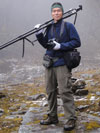
写真家/カワカブ会代表
http://www.k2.dion.ne.jp/~bako/
Naoyuki Kobayashi
Photographer/Representative of Kawagebo Committee
摄影师/卡瓦格博峰协会代表
雲南の最高峰・梅里雪山 その自然と聖地の魅力
雲南省の最高峰梅里雪山で、17人の登山隊員が遭難したのは1991年のことです。それ以来、友人でもある彼らの遺体を探しながら、チベット語でカワカブ(白い雪)と呼ばれるこの山に15年以上通い続けてきました。その過程で見えてきた梅里雪山の自然の限りない奥深さや、大聖山として崇められる山の魅力について、最新の現地訪問報告も交えながらお話します。
The highest peak in Yunnan・Meili Snow Mountain The Charm of nature and the holy land
It was in 1991 people searched for the remains of 17 mountain climbers of the mountain accident. Friends’ efforts of searching their bodies have been lasting in Meili Snow Mountain which was known as Kawakabo (White Snow in Tibetan) for more than 15 years. I will talk about the endless profoundness, the charm of the grand and admirable great holy mountain I witnessed during the process of searching for the deceased, and the latest local interviews.
云南最高峰・梅里雪山以及梅里雪山圣地的魅力
在云南省有17位登山队员遭遇山难是1991年的事情了,从那时起,朋友们在卡瓦格博峰(藏语名为白雪)的山上不断地寻找他们的遗体也超过15个年头了。我想谈谈在此期间我所见的梅里雪山无限深邃的自然,作为大圣山被人崇敬的山之魅力,以及最新参与的当地访谈。
Presented by
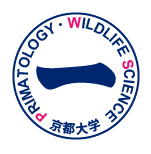
京都大学霊長類学・ワイルドライフサイエンス・リーディング大学院
Leading Graduate Program
in Primatology and Wildlife Science(PWS), Kyoto University
https://pws.wrc.kyoto-u.ac.jp/index.html
Co-Hosted by

岳都・松本 山岳フォーラム2014
山の日制定・信州 山の日制定・中部山岳国立公園指定80周年・八ヶ岳中信高原国定公園指定50周年を祝して、11/29-30に、岳都・松本 山岳フォーラム2014が開催されます。 会場は、当写真展が開催される松本市立美術館と近くの、まつもと市民芸術館です。ぜひ、あわせてお立ち寄りください。
http://www.sangaku.net/
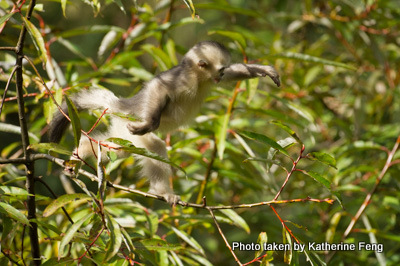
Walking in the treetops
Look, this juvenile can move with ease through the tops of the trees.
漫步于树冠
看!这位少年身轻如燕行走于树顶。
Marcher sur la cime des arbres.
Regardez comme ce juvénile se déplace avec facilité au sommet des arbres.
Andando no topo das árvores
Olhem, este jovem consegue se mover facilmente através do topo das árvores.
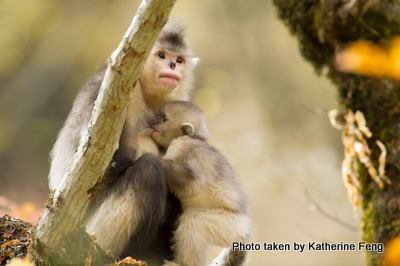
Motherly love
An infant enjoys being cosseted by its mother.
母爱
享受母亲恩宠的婴儿。
L’amour d’une mère
Le petit aime se faire cajoler par sa mère.
Amor materno
Um filhote adora ser mimado por sua mãe.
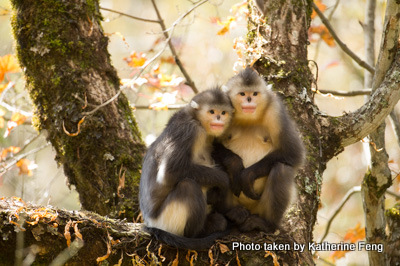
Nice each other
Each family contains several females and they are nice to each other.
友善
每个家庭都有几位雌性,她们之间友善相待。
Gentilles les unes avec les autres
Chaque famille est formée de plusieurs femelles qui sont toujours aimables les unes envers les autres et s’entraident mutuellement.
Gentis umas com as outras
Cada família possui várias fêmeas, que são gentis umas com as outras.
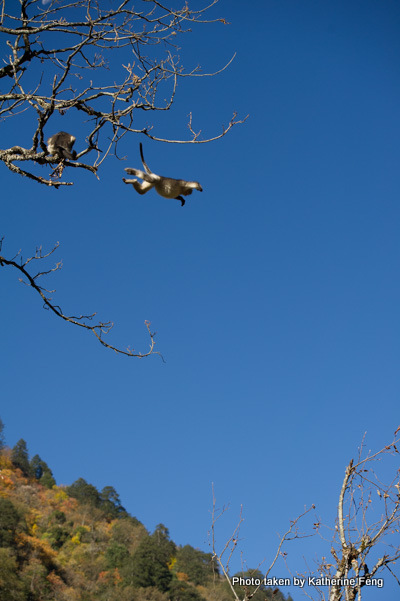
‘Bungee jumping’
This species of monkey is very good at leaping huge distances.
“蹦极”
滇金丝猴个个是蹦极高手
Saut dans le vide
Cette espèce de singes est très douée pour sauter de grandes distances.
‘Bungee jumping’
Esta espécie de macaco é muito hábil para saltar grandes distâncias.
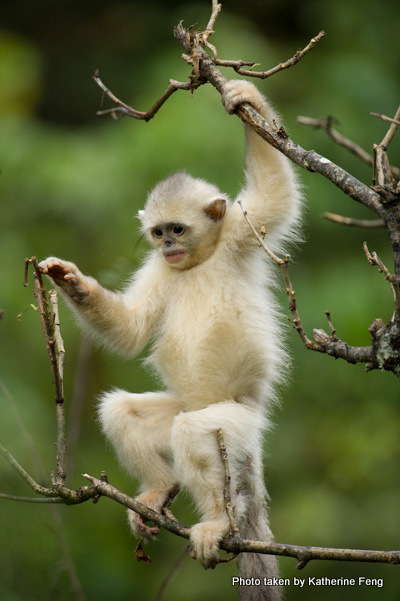
Playful youngster
The juveniles are more active than the adults, and seldom stay still.
嬉戏的少年
少年比成年更活跃,很少静静地呆着。
Garçon joueur
Les juvéniles sont plus actifs que les adultes et restent rarement en place.
Jovem brincalhão
Os jovens são mais ativos do que os adultos e raramente ficam parados.
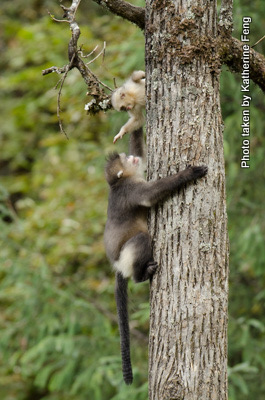
Reaching out
This male infant is reaching out to his mother as she climbs a tree.
伸出援手
妈妈爬树时,雄性婴儿朝妈妈伸出了援手。
A la rescousse
Ce petit mâle essaie d’aider sa mère à grimper à l’arbre.
Ajudando
O filhote tenta ajudar sua mãe enquanto ela escala a árvore.
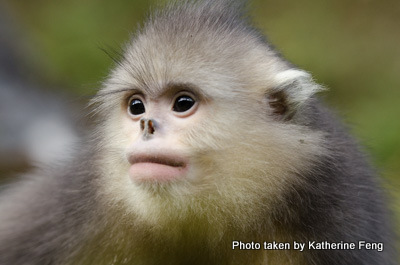
Calm female
Females seem relatively calm and quiet.
平静的雌性
雌性看起来相对平静、祥和。
Femelle sereine
Les femelles semblent plus calmes et plus faciles à vivre.
Fêmea tranqüila
Fêmeas parecem ser mais calmas e quietas.
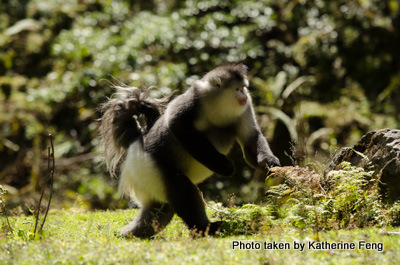
Walking bipedally
Look, this adult male is able to walk bipedally, for a short time.
双足直立行走
瞧啊,这位成年雄性以双足直立走上一会儿呢!
Marche bipède
Regardez comme ce mâle est capable de marcher de façon bipède pendant quelques instants.
Andando bipedalmente
Olhem, por um curto tempo este macho adulto consegue andar de forma bípede
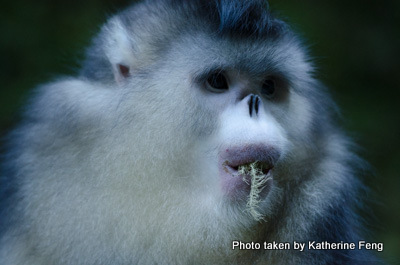
Enjoying munching on lichen
Lichen is the major part of the snub-nosed monkey diet
大嚼特嚼美味松萝
松萝是滇金丝猴食谱的主要成分。
Se régaler de lichen
Le lichen est l’alimentation principale du singe au nez-retroussé.
Saboreando líquens
Líquens compõem a maior parte da dieta do macaco-de-nariz-arrebitado.
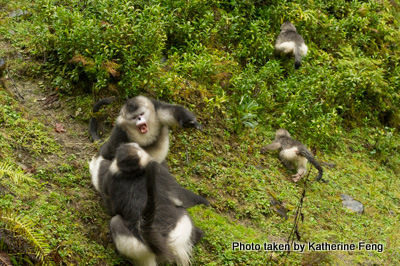
Fighting among males
Males are more aggressive towards each other than are females, demonstrating their strength.
雄性间的争战
比起雌性,雄性间更加充满烟火味,彰显武力。
Combat entre mâles
Les mâles combattent souvent entre eux pour montrer leur force.
Briga entre machos
Machos são mais agressivos entre si que as fêmeas, demonstrando assim, sua força.
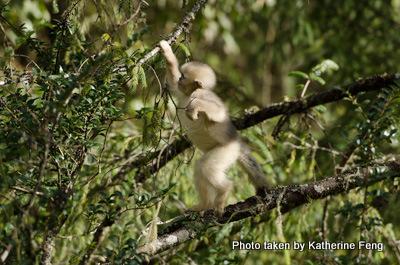
Standing up
This juvenile walks bipedally with relative ease.
站起身来
这位少年居然相当轻松地直立行走。
Debout
Ce juvénile marche sur ses deux pieds avec une aisance relative.
Em pé
Este jovem anda em pé com certa facilidade.
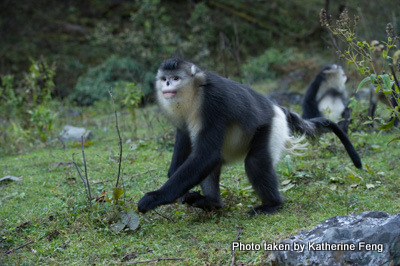
Bipedal walk
Look, this male demonstrates walking bipedally.
直立行走
瞧,这位雄性展现直立行走的身姿。
Marche bipède
Regardez, ce mâle fait une démonstration de marche bipède.
Andando de pé
Olhem, este macho demonstra saber andar bipedalmente.
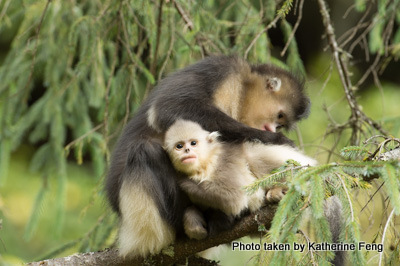
Mother grooming her infant
Infants are groomed mostly by their mothers.
母亲为婴儿理毛
婴儿大多由各自的母亲理毛。
Toiletté par la mère
Les petits sont généralement toilettés par leurs mères.
Mãe limpando sua cria
Na maior parte das vezes, os bebês são limpos pelas suas mães.
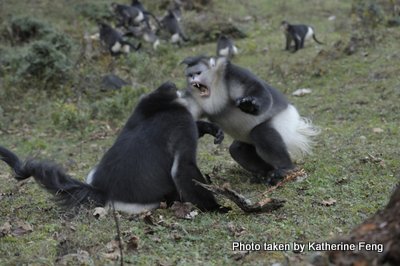
Fighting among males
Males frequently fight with each other to advertise their strength.
雄性间的争战
雄性常打架以示威力无比。
Combat entre mâles
Les mâles combattent souvent entre eux pour montrer leur force.
Briga entre machos
Machos frequentemente brigam entre si para mostrar sua força.
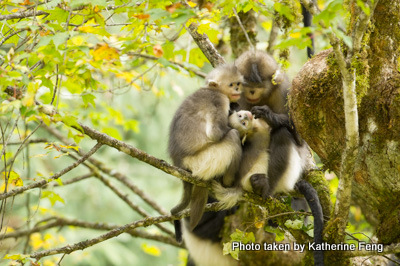
Mother grooming her infant
Infants are groomed mostly by their mothers.
母亲为婴儿理毛
婴儿通常由各自的母亲理毛。
Toiletté par la mère
Les petits sont généralement toilettés par leurs mères.
Mãe limpando sua cria
Os bebês são limpos majoritariamente pelas suas mães
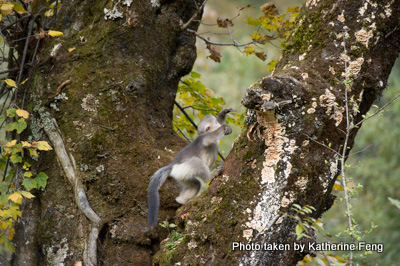
Climbing
Climbing is a skill essential to survival, but takes practice to perfect.
攀爬
攀爬是基本生存技能,但是需要练习而日臻完美。
Grimper
Etre capable de grimper est essentiel pour la survie mais nécessite beaucoup de pratique pour y parvenir.
Escalando
A escalada é uma habilidade essencial para sobrevivência, mas é preciso prática para atingir a perfeição.
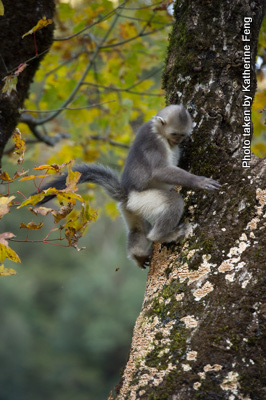
Climbing
Climbing is a skill essential to survival, but practise makes perfect...
攀爬
攀爬是基本生存技能,但是熟能生巧……
Grimper
Etre capable de grimper est essentiel pour la survie mais nécessite beaucoup de pratique pour y parvenir.
A escalada é uma habilidade essencial para sobrevivência, mas é preciso prática para atingir a perfeição.
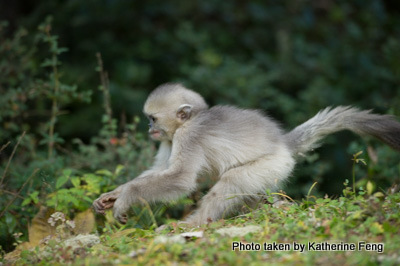
Bipedal running
A juvenile monkey attempts to run bipedally.
双足直立奔跑
一位少年猴试图直立奔跑。
Course bipède
Il semble que ce juvénile essaie d’apprendre la course bipède.
Corrida bípede
Um jovem macaco tenta correr bipedalmente.
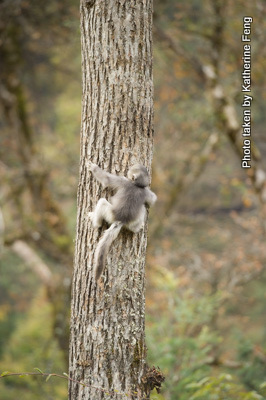
Vertical climbing - scaling a tree-trunk
Climbing is a skill essential to survival, but takes practice to perfect.
垂直攀爬 — 沿着树干爬
攀爬是基本生存技能,但是需要练习而日臻完美。
Grimper
Etre capable de grimper est essentiel pour la survie mais nécessite beaucoup de pratique pour y parvenir.
Escalada vertical – subindo um tronco de árvore.
A escalada é uma habilidade essencial para sobrevivência, mas é preciso prática para atingir a perfeição.
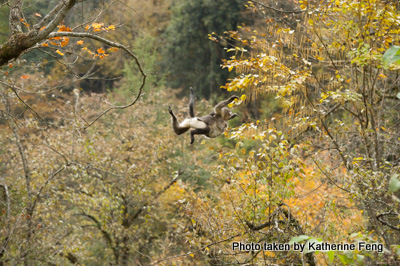
Deft mothers
Mothers are capable of leaping large distances, even with the weight of their infant clinging to them.
敏捷众妈咪
哪怕有紧紧依附在身上婴儿的体重坠着,妈咪们个个擅长远距离跳跃。
Mère courage
Les mères peuvent aussi sauter de très haut avec leurs bébés.
Mães habilidosas
Mães são capazes de saltar grandes distâncias, mesmo com o peso de suas crias agarradas a elas.
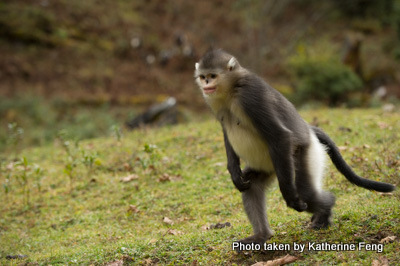
Bipedal walking
Look at this male - walking bipedally
双足直立行走
看这位仁兄— 双足直立行走。
Marche bipède
Regardez comme ce mâle est capable de marcher de façon bipède.
Andando de pé
Olhem este macho – andando bipedalmente.
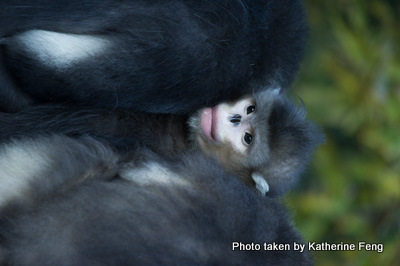
Keeping warm
It gets so cold that the monkeys benefit from huddling close together to conserve heat and keep each other warm.
取暖
天气严寒,猴子们抱团以保存热量并相互保暖。
Garder la chaleur
Comme il fait très froid, les singes se tiennent serrés les uns contre les autres pour avoir chaud.
Se mantendo aquecidos
Como faz frio, os macacos se agrupam para preservar o calor.
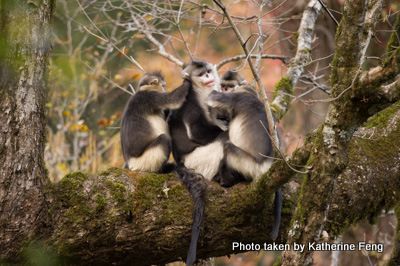
Being groomed by three females
This male is enjoying being groomed by three 'wives' - females.
三“妻”理毛
这位雄性正享受三“妻”理毛的待遇。
Toiletté par trois femelles
Ce mâle apprécie d’être toiletté par ses trois femelles.
Sendo limpo por três fêmeas.
Este macho está apreciando ser limpo por suas três ‘esposas’.
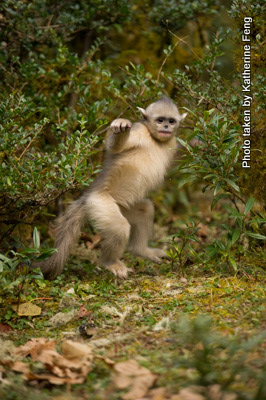
Standing-up
This juvenile walks bipedally with apparent ease.
站起身来
这位少年轻轻松松就能双足直立行走。
Debout
Ce juvénile marche sur ses deux pieds avec une aisance visible.
De pé
Este jovem anda em pé com certa facilidade.
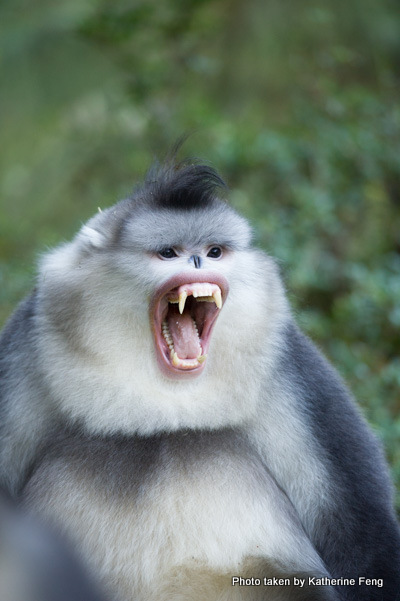
Baring teeth
Males display their large canines, from time to time.
别惹我
大公猴会不时显示其大獠牙,以表示其孔武有力。
Montrer les dents
De temps en temps, les mâles montrent leurs grosses canines.
Mostrando os dentes
De vez em quando, os machos mostram seus enormes caninos.
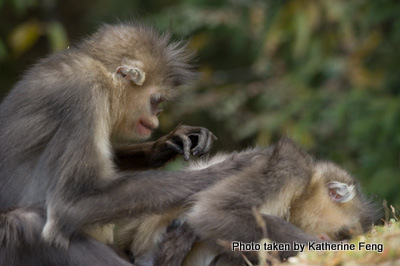
Nimble fingers
The Yunnan golden monkey has relatively dextrous hands and their fingernails are very similar to our own.
灵活的手指
滇金丝猴的双手相当灵活,它们的指甲与人类的指甲很相似。
Les doigts agiles
Le singe d’or de Yunnan a des doigts agiles et leurs ongles ressemblent à ceux des humains.
Dedos ágeis
O macaco-dourado de Yunnan tem mãos relativamente hábeis e suas unhas são muito similares às nossas.
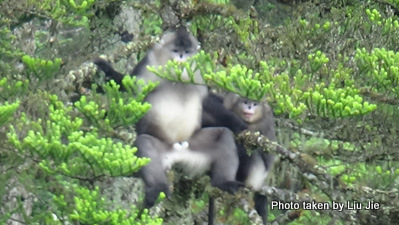
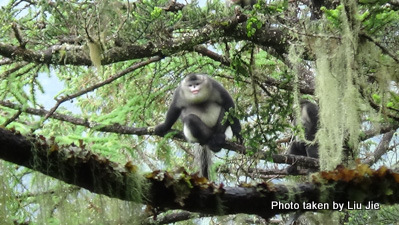
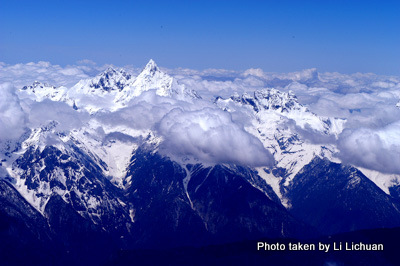
Kawagebo Peak 6740m of Meili-Xueshan, the north-east viewed from the sky
空から見た梅里雪山カワカブ峰の北東面
梅里雪山卡瓦格博峰6740米,空中俯瞰东北角度
Vue Nord-Est aérienne du sommet Kawagebo (6740mètres) de Meili-Xueshan.
Pico Kawagebo (6.740 metros), cadeia de montanhas Meili-Xueshan, vista aérea do nordeste da montanha.
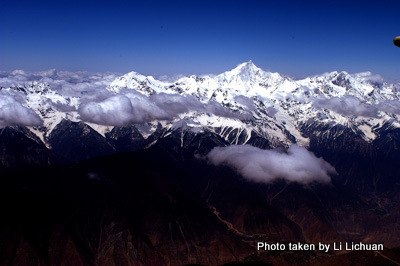
Kawagebo Peak 6740m and the satellite peaks of Meili-Xueshan, viewed from the sky
空から見た梅里雪山カワカブ峰とその衛生峰
卡瓦格博峰6740米,卫星航拍梅里雪山诸峰
Vue aérienne du sommet Kawagebo (6740 mètres) de Meili-Xueshan.
Pico Kawagebo (6.740 metros) e os picos ‘satélites’ por vista aérea.
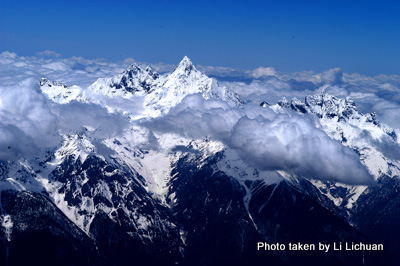
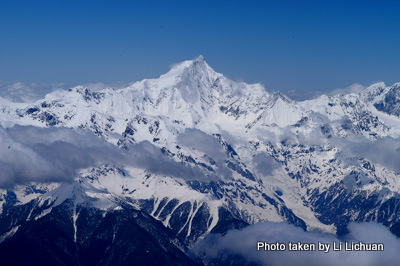
Kawagebo Peak 6740m of Meili-Xueshan, the east face viewed from the sky
空から見た梅里雪山カワカブ峰の東面
梅里雪山卡瓦博格峰6740米,航拍东面
Vue aérienne de la face Est du sommet Kawagebo de Meili-Xueshan (6740 mètres).
Pico Kawagebo (6.740 metros), cadeia de montanhas Meili-Xueshan, face leste vista do céu.
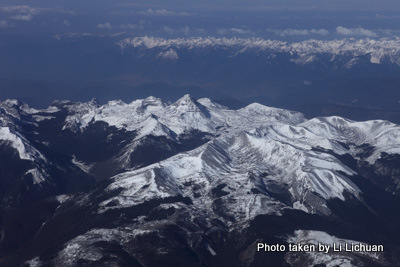
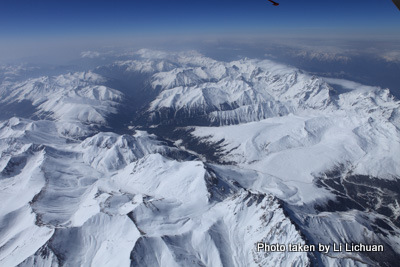
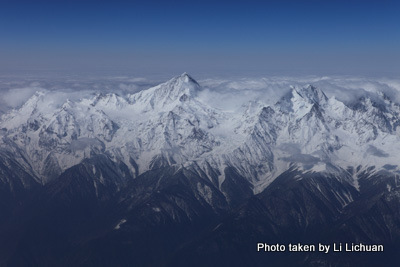
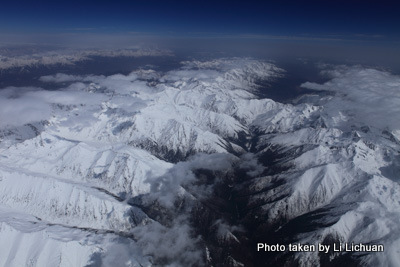

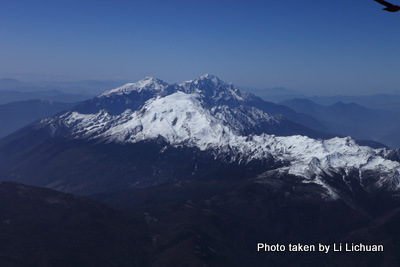
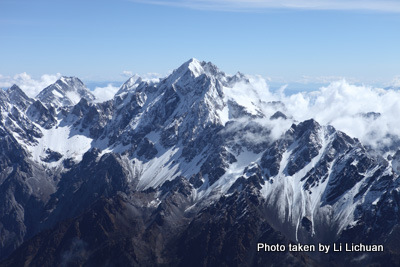
Baima Xueshan (Zhalaqueni) 5429m the north east viewed from the sky
空から見た白馬雪山5429mの北東面
白马雪山(珠峰扎拉雀尼)5429米 航拍东北角度
Vue Nord-Est aérienne (5429 mètres) de Baima Xueshan (Zhalaqueni)
Baima Xueshan (Zhalaqueni), 5.429 metros, Nordeste visto do céu.
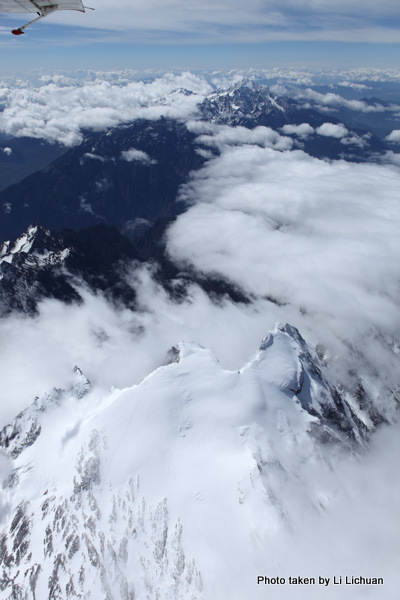

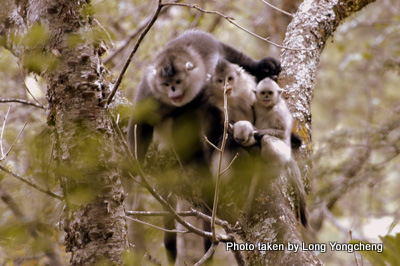
Striking sexual dimorphism
This is a Yunnan snub-nosed monkey family with four members: father, mother and two infants. Look how large the father is relative to the others! His body weight is at least three times that of the mother. The monkey exhibits the most obvious sexual dimorphism among all the mammals, that is, a striking difference in relative body size between males and females of the same species.
显著的性二型性
图为一家四口的滇金丝猴成员:父亲、母亲和两个宝宝。看那位父亲庞大的体型!他的体重至少是母亲的三倍。滇金丝猴在所有的哺乳动物中显现最显著的性二型性,即同种雌性与雄性的相对体型明显不同。
Dimorphisme sexuel frappant
Il s’agit d’une famille de singes au nez retroussé de Yunnan avec 4 membres : le père, la mère et leurs deux enfants. Regardez comme le père est énorme ! Son poids fait au moins trois fois celui de la mère. Cette espèce de singe présente le dimorphisme sexuel le plus évident parmi tous les mammifères, caractérisé par une différence significative dans la taille du corps entre les mâles et les femelles.
Forte dimorfismo sexual
Esta é uma família de macacos-de-nariz-arrebitado de Yunnan, com quarto membros: pai, mãe e duas crianças. Veja o quão grande o pai é em comparação aos demais! Seu peso é pelo menos três vezes maior que o da mãe. Esta espécie apresenta o mais evidente dimorfismo sexual entre todos os mamíferos, ou seja, apresentam uma forte diferença em tamanho relativo do corpo entre machos e fêmeas da mesma espécie.
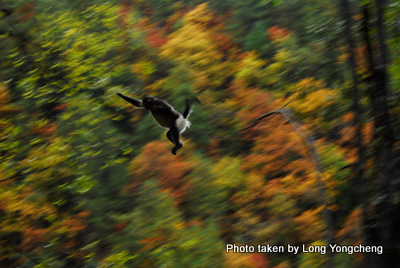
‘Flying’ monkey
The Yunnan golden monkey has an adeptness for ‘acrobatics’ - leaping huge distances between trees with accuracy. Unlike human gymnasts, they require no safety net.
雲南キンシコウの跳躍力を示すアクロバットのような一瞬をとらえた
“飞”猴
滇金丝猴有娴熟的“杂技”— 精确地跳跃“飞越”树与树之间的巨大间距。与人类体操健将不同的是它们不需要安全网。
Singe volant
Les singes d’or de Yunnan ont tous la capacité de faire des « acrobaties », et leurs performances ne nécessitent aucune précaution particulière.
Macaco voador
Os macacos-dourados de Yunnan tem uma aptidão para ‘acrobacias’ – saltando grandes distâncias entre árvores com precisão. Ao contrário de ginastas humanos, eles não precisam de rede de proteção.
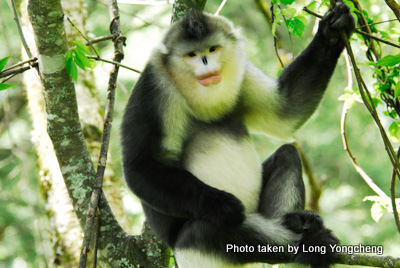
Stocky
Male Yunnan golden monkeys are typically large and of stocky build.
雲南キンシコウの男性は、女性よりも体が大きく太って見える
身姿健硕
雄性滇金丝猴通常体型庞大、身姿健硕。
Grassouillet
Le singe mâle d’or de Yunnan est en général grand et trapu.
Robusto
Machos da espécie macaco-dourado de Yunnan são geralmente grandes e parrudos.
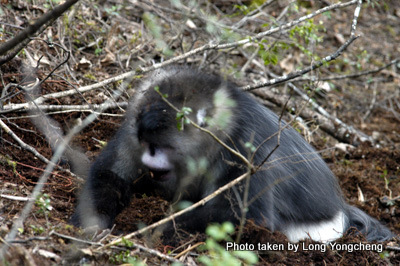
Photo taken by Long Yongcheng
Rooting out underground tubers
Yunnan golden monkeys feed down on the ground pretty often, sometimes even searching for and digging up underground roots and tubers.
挖出块茎
滇金丝猴时常吃地下的东西,有时甚至觅食到地下,挖掘植物地下的根和块茎。
A la recherche de tubercules
Les singes d’or de Yunnan se nourrissent fréquemment au sol et ils peuvent même de temps en temps extraire des tubercules du sol.
Desenterrando tubérculos do subsolo
Os macacos-dourados de Yunan se alimentam frequentemente do solo, e às vezes até procuram e desenterram raízes e tubérculos da terra.
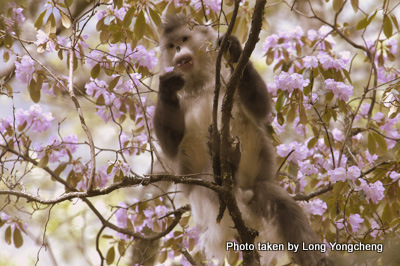
Edible flowers
Rhododendron flowers are also edible to these monkeys.
可食花
杜鹃花对于滇金丝猴来说,也可食。
Fleurs comestibles
Les fleurs de rhododendron sont également comestibles pour les singes.
Flores comestíveis
As flores rododendro são igualmente comestíveis para estes macacos.
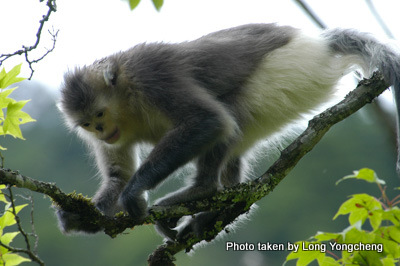
Feeding on lichens
This monkey appears incredibly focused on eating tree-bark lichens. These monkeys are known to feed on a wide variety of lichens - unusual in a mammal.
取食松萝
这位滇金丝猴聚精会神地吃松萝。滇金丝猴以吃各种不同种类的松萝而著称 — 在哺乳动物中实属罕见。
Se nourrir de lichens
Ce singe est extrêmement concentré lorsqu’il se nourrit de lichens. Ces singes sont connus pour se nourrir d’une variété de lichens et c’est inhabituel chez les mammifères.
Se alimentando de líquens
Este macaco parece incrivelmente focado em comer líquens das cascas de árvores. Estes macacos são conhecidos por se alimentar de uma vasta variedade de líquens, algo raro em mamíferos.
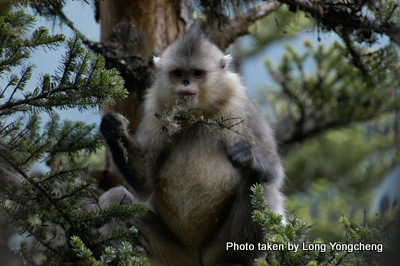
Monkey diet
By the end of winter, all the lichen on the trees has all been eaten. Fortunately, new lichen will soon appear, come spring.
猴子的食谱
冬末,树上所有松萝都被吃光了。所幸,来年春新的松萝即将出现。
L’alimentation des singes
Les lichens sur les arbres ont été mangés après l’hiver. Heureusement, les nouvelles pousses arriveront bientôt au printemps.
Dieta de macaco
No fim do inverno, todos os líquens nas árvores já foram comidos. Felizmente, novos líquens irão aparecer em breve na primavera.
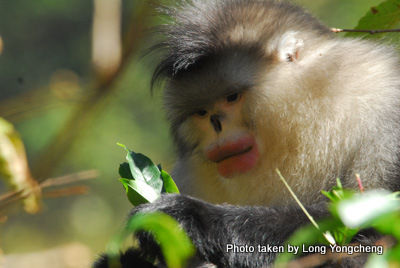
Leaf-eaters
During spring and summer, Yunnan golden monkeys eat a large quantity of leaves of many different plants. Researchers think that this may even ‘hep’ the health of the forest, as a natural form of tree-pruning.
食叶一族
滇金丝猴在春夏之际吃大量各种不同植物的树叶。研究人员认为这也许甚至“有助于”森林健康,作为一种修剪树叶的形式。
Mangeur de feuilles
Les singes d’or de Yunnan mangent également une grande quantité de feuilles diverses au printemps et en été, ce qui peut participer à un élagage naturel des arbres dans la forêt.
Comedores de folhas
Durante a primavera e o verão, os macacos-dourados de Yunnan comem uma grande quantidade de folhas de muitas plantas diferentes. Pesquisadores acreditam que isto até mesmo ajude à saúde da floresta, como uma forma natural de poda.
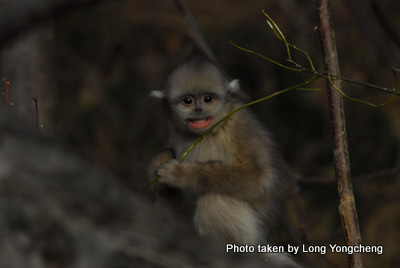
Learning to find food
This juvenile is biting bark from a branch. He may be either feeding or perhaps just trying out his teeth.
学习觅食
这位少年正从树枝上咬树皮,也许他要么在吃东西,要么只是在练牙。
Apprendre à chercher de la nourriture
Ce juvénile est en train de mordre de l’écorce d’une branche d’arbre. Peut-être se nourrit-il ou peut-être est-il seulement en train d’apprendre à se servir de ses dents.
Aprendendo a achar comida
Este jovem morde a casca de um galho. Talvez ele esteja ou se alimentando, ou apenas testando seus dentes.
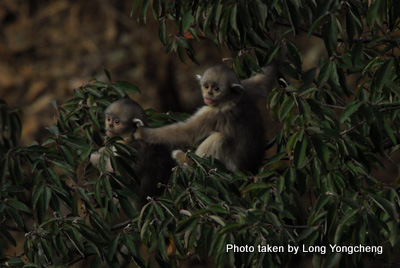
Playing
Juveniles enjoy playing together. Playing is most likely essential to their survival, preparing them for adult life.
嬉戏
少年猴们喜欢一起嬉戏。嬉戏很有可能对其生存必不可少,为成年生活做准备。
Jouer
Les juvéniles adorent jouer les uns avec les autres et un tel comportement est essentiel pour leur survie et indispensable pour accéder à l’âge adulte.
Brincando
Jovens gostam de brincar juntos. Este ato é provavelmente essencial para sua sobrevivência, os preparando para a vida adulta.
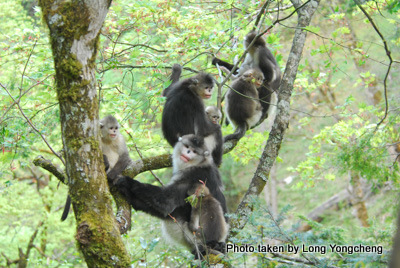
Monkey sleeping-site
This family are all sharing the same branch and are soon to fall sleep there.
猴子睡觉的地方
这一家子共享同一树枝,迅速入眠。
La maison des singes
Cette famille est restée sur une branche et bientôt tous s’y endormiront.
Local de dormir dos macacos
Nesta família, todos partilham o mesmo tronco e logo irão adormecer nele.



Western face of Meili snow mountains
Face Ouest des montagnes Meili
Face oeste das montanhas nevadas Meili.

Western face of Meili snow mountains
Face Ouest des montagnes Meili
Face oeste das montanhas nevadas Meili.

Western face of Meili snow mountains
Face Ouest des montagnes Meili
Face oeste das montanhas nevadas Meili.

Western face of Meili snow mountains
Face Ouest des montagnes Meili
Face oeste das montanhas nevadas Meili.
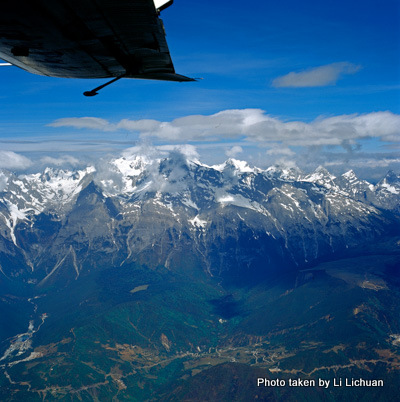
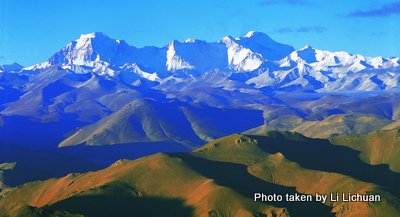
Zhuoaoyou snow mountain (卓奥友雪山)
Montagne Zhuoaoyou.
Montanha Nevada Zhuoaoyou
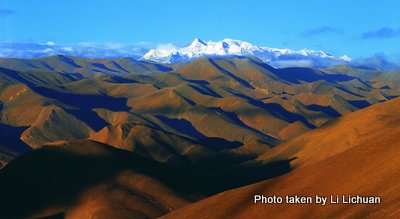
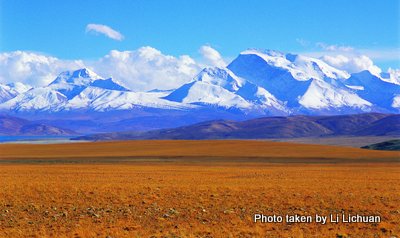
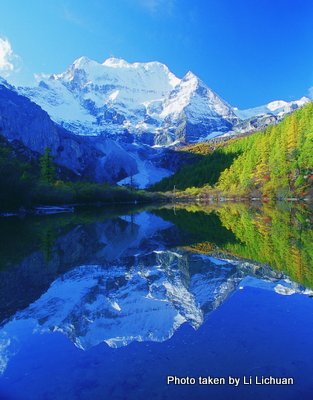
Xiannairi snow mountain (仙乃日雪山) Baima Xueshan 5429m
白馬雪山の北峰のXiannairi雪山(Xiannairiとはチベット語で「観音様」との意味)
白马雪山北峰(仙乃日雪山)5429米
Montagne Xiannairi, Baima Xueshan (5429 mètres).
Montanha nevada Xiannairi, Baima Xueshan 5.429 metros
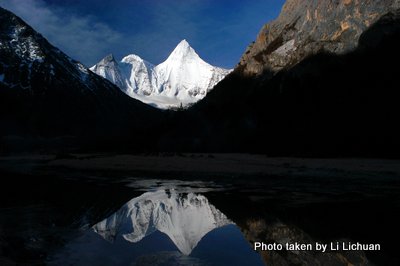
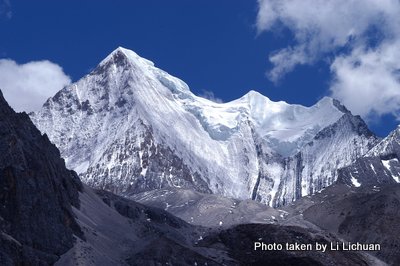
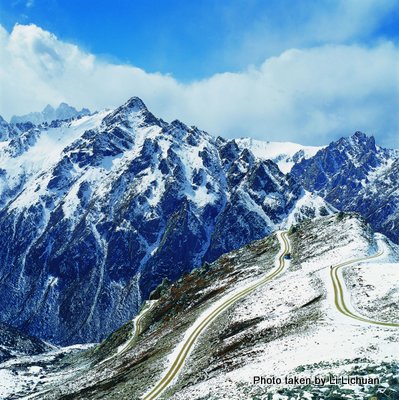
Baima Xueshan 5429m
白馬雪山5429m
Baima Xueshan 5429 mètres
Baima Xueshan 5.429 metros
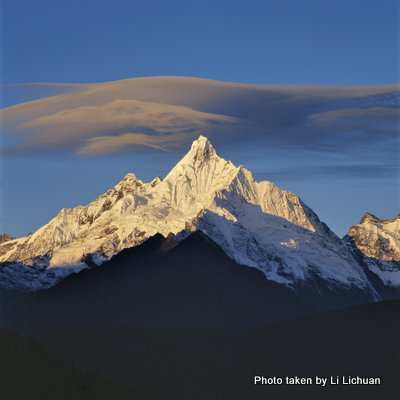
Meili snowy mountains: east face of Dameiyong.
梅里雪山:Dameiyongの東面
梅里雪山:大梅庸雪山东面
Montagne Meili ; La face Est de la montagne Dameiyong.
Montanhas nevadas Meili: face leste de Dameiyong.
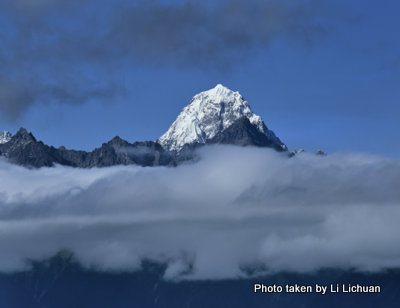
Meili snowy mountains: east face of Dameiyong.
梅里雪山:Dameiyongの東面
梅里雪山:大梅庸雪山东面
Montagne Meili ; La face Est de la montagne Dameiyong.
Montanhas nevadas Meili: face leste de Dameiyong.
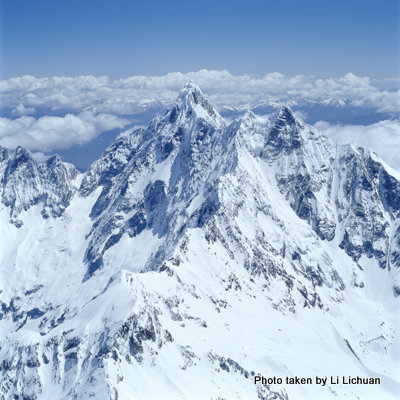
Meili snowy mountains: the west face of Metsumo peak
梅里雪山のメツモ峰西面
Montagne Meili ; La face Ouest du sommet Metsumo.
Montanhas nevadas Meili: face oeste do pico Metsumo
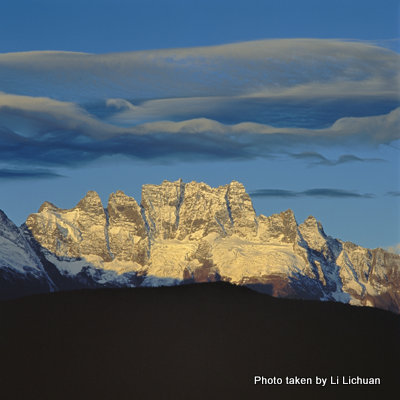
Meili snowy mountains: the west face of Wuguan peak
梅里雪山のウグアン峰
梅里雪山:五冠峰西面
Montagne Meili ; La face Ouest du sommet Wuguan.
Montanhas nevadas Meili: face oeste do pico de Wuguan
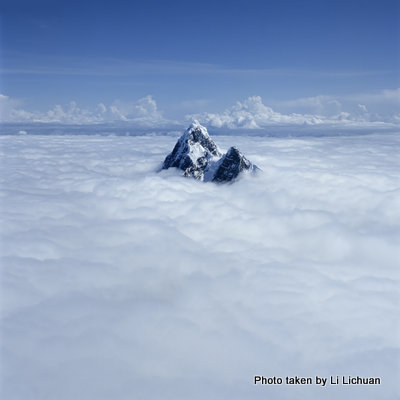
Meili snowy mountains: Metsumo peak - bird's eye view taken at an altitude of 7000m
7,000m上空から見た梅里雪山メツモ峰
从7000米高空鸟瞰梅里雪山神女峰
Montagne Meili ; vue aérienne du sommet Metsumo à 7000 mètres d’altitude.
Montanhas nevadas Meili: pico Metsumo – vista aérea, altitude 7.000 metros.
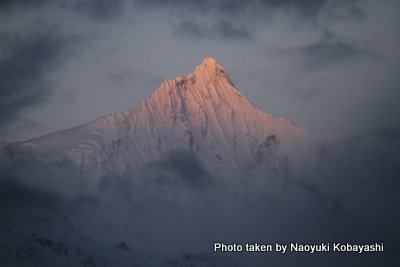
Kawagebo: the highest peak of Meili Snow mountain range(6,740m, East face)
梅里雪山山群の主峰カワカブ(6,740m、東面)
梅里雪山山脉主峰卡瓦格博峰(6740米,东面)
Kawagebo : le plus haut sommet de la montagne Meili (6740 mètres, face Est).
Kawagebo: o pico mais alto da cadeia de montanhas nevadas Meili (6.740 metros, face leste)
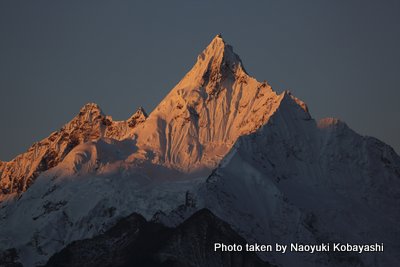
Metsumo Peak (6,054m) of Meili Xueshan, a wife of Kawagebo Peak
カワカブの后といわれる尖峰メツモ(6,054m)
梅里雪山神女峰(6054米),卡瓦格博之妻
Sommet Metsumo (6054 mètres) de Meili Xueshan.
Pico Metsumo (6.054 metros) de Meili Xueshan, parceiro do pico Kawagebo.
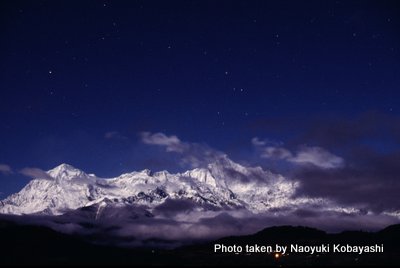
A full moon illuminates Meili bright; Ablazing from the village of Feilai Temple echoes the moonlight
満月に照らされた梅里雪山。下に飛来寺村の明かりが見える
一轮满月照梅里,飞来寺村灯火明。
La pleine lune illumine la montagne Meili ; Brillante à partir du village du temple Feilai.
A lua cheia ilumina Meili; irradiando da vila de Templo Feilai, ecoa a lua.
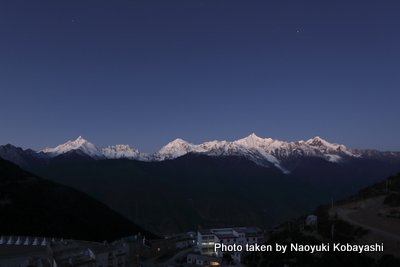
黎明の刻に朝日が当たり始めた梅里雪山の山群。手前に飛来寺村のホテルが見える
从飞来寺村的宾馆可以看到黎明破晓前朝阳映照的梅里雪山群山。
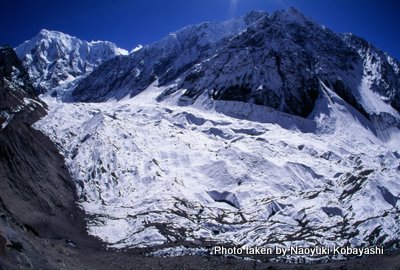
Kawagebo Peak of Meili Xueshan, North west face and the glacier from the ground
カワカブの北西面と北西側の氷河
梅里雪山卡瓦格博峰,西北面与西北侧的冰川
Face Nord-Ouest du sommet Kawagebo de Meili Xueshan et le glacier vus du sol.
Pico Kawagebo de Meili Xueshan, face noroeste e geleira.
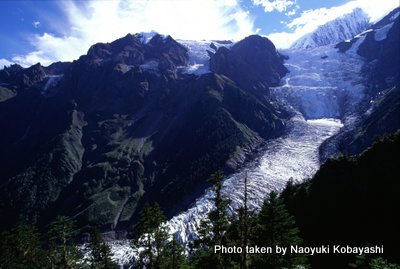
East face of Kawagebo Peak and East side of Mingyong Glacier. Mingyong Glacier runs under the woods range.
カワカブの東面と東側の明永氷河。樹林帯より下に氷河が流れる
卡瓦博格峰的东面和东侧的明永冰川,冰川在树林带下流淌。
Face Est du sommet Kawagebo et partie droite du glacier Mingyong. Le glacier Mingyong s’étend sous les bois.
Face leste do pico Kawagebo e parte leste da geleira Mingyong. A geleira de Mingyong corre na área dos bosques.
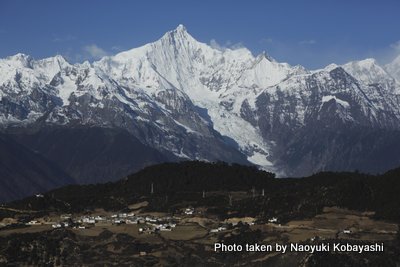
The East face of Kawagebo Peak and Village of Feilai Temple
カワカブの東面と飛来寺村
卡瓦博格峰的东面和飞来寺村
Face Est du sommet Kawagebo et du village du temple Feilai.
Face leste do pico Kawagebo e a vila de Templo Feilai.
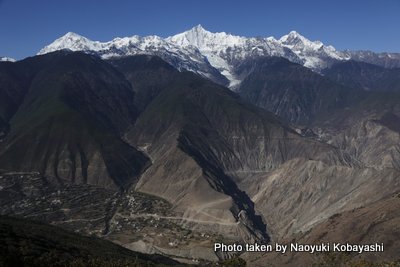
A view of Meili Snow mountain from the Valley of Lancang River (the Mekong River). The elevation difference from the river bed to the summit is more than 4,700m.
メコン川(瀾滄江)の峡谷を隔てて望む梅里雪山。川床から山頂までの標高差は4,700m以上
隔澜沧江(在越南境内叫湄公河)峡谷眺望梅里雪山。河床到山顶的海拔差4700米以上
Vue de la montagne Meili à partir de la vallée de la rivière Lancang (la rivière du Mekong). La différence d’élévation du lit de la rivière au sommet est de plus de 4700 mètres.
Vista da montanha Nevada Meili a partir do vale do rio Lancang (rio Mekong). A altitude entre o leito do rio e o topo é de mais de 4.700 metros.
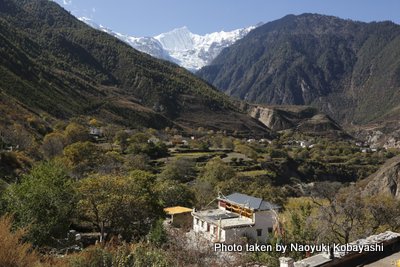
A view of Kawagebo Peak from autumn-tint Mingyong Village
黄葉につつまれた明永村から望むカワカブ
从秋叶尽染的明永村眺望卡瓦格博峰
Vue du sommet Kawagebo à partir du village de Mingyong sous les couleurs d’automne.
Vista do pico Kawagebo da vila Mingyoun sob a matiz do outono.
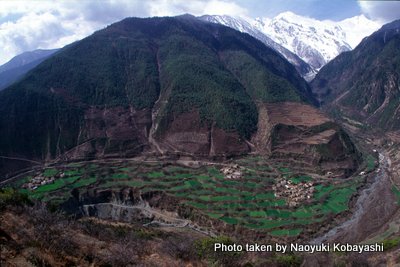
Mingyong Village in Spring and Kawagebo Peak. The water thawed from the Glacier moistened Mingyong Village all the year round.
春の明永村とカワカブ。明永村は氷河の融解水によって1年中潤う
春之明永村和卡瓦博格峰。冰川融水一年四季滋润着明永村。
Le village Mingyong et le sommet Kawagebo au printemps. L’eau fondue du glacier humidifie le village de Mingyong toute l’année.
Vila Mingyong na primavera e o pico Kawagebo. O degelo abastece a vila Mingyoung durante o ano.
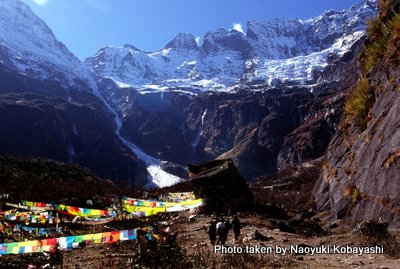
Tibetan pilgrims walking to the fall of the glacier of Meili Xueshan
奇峰ジャワリンガ(5,470m)の懸垂氷河から落ちる滝をめざして巡礼する人々
Les pèlerins tibétains marchent jusqu’à la chute du glacier de Meili Xueshan.
Peregrinos tibetanos caminhando em direção à queda da geleira de Meili Xueshan.
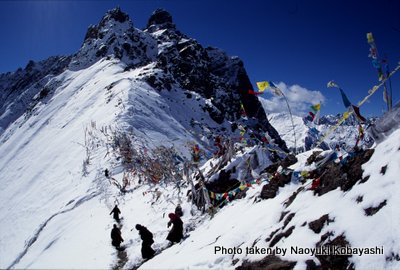
梅里雪山山群を一周する巡礼路上の峠ドケラ(4,480m)。メコン川とサルウィン川の分水嶺
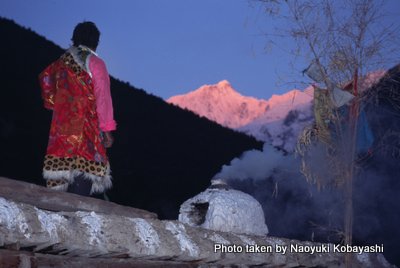
The people living in the area prey to the sacred peak Kawagebo every morning
山麓に暮らす人々は、毎朝香をたいてカワカブに祈りを捧げる
Chaque matin, les personnes vivant dans cette région prient pour le mont sacré Kawagebo.
As pessoas da região rezam toda manhã para o pico sagrado Kawagebo.
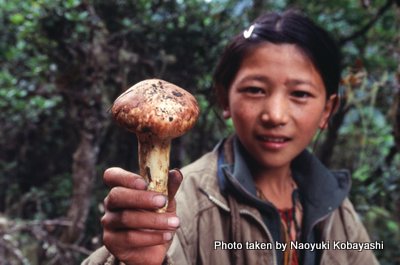
梅里雪山の山麓で採れる松茸。常緑のカシの木の近くに生える
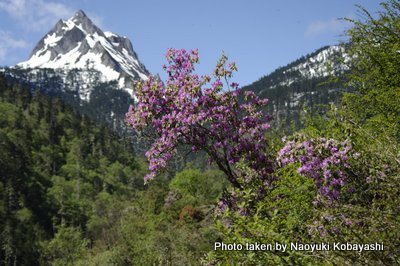
Flower of Rhododendron with a satellite peak of Kawagebo
カワカブの守護神とされるシャマヤ峰を背景に、高木のツツジが生える。
Fleur de Rhododendron avec le sommet Kawagebo
Flor de Rododendro com o pico Kawagebo.
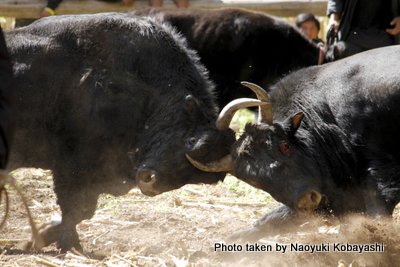
梅里雪山の山麓で行なわれるゾ(ヤクと牛の交配種)の闘牛

